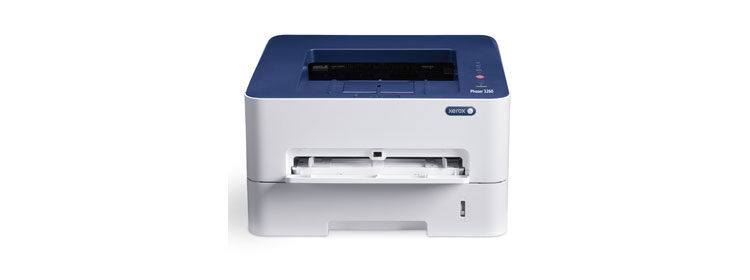If output quality is your primary consideration for a personal monochrome laser printer or a shared laser in a micro office, the Xerox Phaser 3260/DI ($189) may be the one you want. It’s easy to find competing models that beat it for speed, paper handling, or running cost, but the 3260/DI$159.00 at WalMart stands out in its price class for its output quality overall, and particularly for graphics.
Obvious head-to-head competitors include the OKI B412dn$199.98 at Amazon that I recently reviewed, and the Brother HL-5450DN$147.99 at Amazon, which is our Editors’ Choice medium- to heavy-duty monochrome laser for personal use or for shared printing in a micro office or workgroup. All three are small enough to sit on your desk without taking up a lot of room, but capable enough to share among several users.
Unlike the OKI and Brother models, the 3260/DI lacks an Ethernet connector, which means you can’t connect it directly to a wired network. However, it supports Wi-Fi, so you can connect it through an access point. A more important difference is that the 3260/DI doesn’t match either the OKI or Brother printers for paper handling. All three offer a 250-sheet paper tray and duplexer (for two-sided printing) standard. However, the 3260/DI supplements that with only a single-sheet manual feed. The OKI and Brother printers both include multipurpose trays, with a 50-sheet capacity for the OKI B412dn and a 100-sheet capacity for the Brother HL-5450DN. Both also let you upgrade to a total capacity of 800 pages or more. The 3260/DI doesn’t offer any additional trays. If you need more capacity, you’ll have to look elsewhere.
Another key difference is running cost. The claimed cost per page for both the OKI B412dn and the Brother HL-5450DN is about 2 cents. Xerox puts the cost per page for the 3260/DI at 3.4 cents. The difference works out to well over $100 per 10,000 pages. Depending on how much you print, you could easily save enough in running cost with either the OKI or Brother printer to pay for the initial price of the printer.
Basics, Setup, and Speed
Like more and more printers, the 3260/DI offers mobile printing, although it’s limited to support for Apple AirPrint and for printing though the cloud. If you connect the printer to a network, you can print to it from iOS smartphones and tablets—as well as Apple computers that support AirPrint—over your Wi-Fi access point. If you choose to connect to a single PC via USB cable instead, you won’t be able to print through the cloud, but you can still take advantage of the printer’s Wi-Fi Direct support to connect to it directly and print using AirPrint.
Setup is typical for the breed. At 8.4 by 14.5 by 13.2 inches (HWD), the 3260/DI is small enough to share a desk with comfortably, and at 16 pounds 13 ounces, it’s easy for one person to move into place. For my tests, I connected it to a Windows Vista system by USB cable.
Xerox’s rates the engine at 29 pages per minute (ppm) in simplex (one-sided printing) mode, but the driver installs to print in duplex mode by default. (Xerox doesn’t provide a rating for duplex printing.) I timed it on our business applications suite (using QualityLogic’s hardware and software for timing) at a respectable, but not impressive, 9.2ppm in simplex and 7.1ppm in duplex. That makes it essentially tied with the OKI B412dn, at 9.6ppm for simplex, and just a touch slower than the Brother HL-5450DN, at 10.8ppm.
Output Quality
The saving grace for the 3260/DI, and the main reason to consider it, is its output quality. Text is in the middle of a fairly tight range that most monochrome laser printers fall in, making it not quite good enough for high-quality desktop publishing, but easily suitable for any other business use.
Graphics output is in the top tier for monochrome lasers, which also translates to being good enough for any business need where monochrome output is appropriate. Unless you need color, it’s easily good enough for PowerPoint handouts and the like. Similarly, photo output is better than most monochrome lasers can manage, making it suitable for, say, newsletters, if you’re inclined to print your newsletters instead of sending them electronically.
If you don’t need particularly high-quality output, either the OKI B412dn or Brother HL-5450DN is likely to be a better fit, with the Editors’ Choice Brother HL-5450DN offering faster speed and better text quality, and the OKI B412dn offering a slightly lower claimed cost per page and slightly better paper handling. If your primary concern is output quality, however, particularly for graphics and photos, and you don’t mind the higher running cost, the Xerox Phaser 3260/DI is a more than reasonable choice, and can easily be the best fit.
original article







